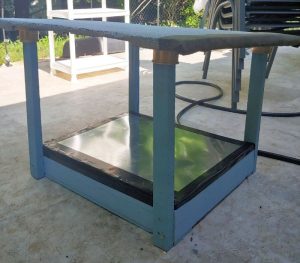Our shelter activities
MC C³ provides support on an as-available basis for caretakers needing shelters or feeding stations for their colony cats. Our intention is to always have some shelters available ready-made.
Building houses, like all of our programs, is an all volunteer activity, and availability of houses may vary.
We may also provide support in the form of suggestions of particular items and sources of supply for building or buying shelters and feeding stations; or instructions for construction.
We encourage all caretakers to build their own shelters whenever possible.

If you are part of a volunteer public-service group that would like to build shelters, please get in touch with us via our contact form. Also please use this form if you would like to donate materials. If you would like to volunteer as an individual for shelter building or other activities, please fill out our volunteer form.
Good design features
Small shelters or houses can be placed in some colony sites to help keep community cats out of the weather. Experience has shown that the following features are generally best for the cats:
- Two openings above ground level.
- The two openings are so the cat can escape if cornered in the shelter.
- They should be above ground level to keep the inside dry if water pools around the shelter.
- They should be high enough up on the sides to leave room for filling the shelter partway with straw (see below).
- They should face at right angles so wind doesn’t blow through.
- They should be protected, if possible, by small overhangs (see pictures below).
- Insulation—not fiberglass like you see in attics, but something like the thin, foil-covered insulation that comes in rolls, or white styrofoam. If the insulation is thin and floppy, go ahead and put it over the openings, but cut it along the bottom three sides of the opening so it’ll act like a door.
- Straw. Fill it up halfway or more with straw—not hay, which still has the grain heads on it and will attract rodents.
- Access to clean the shelter and change the straw when necessary. Usually this means some kind of removable roof.
- Waterproof material or a roof constructed to shed water.

Left: Wooden shelter with door overhangs and a slanted roof. Center: Plastic shelter made from storage tub with door overhangs (second door not visible from this angle). Right: Styrofoam shelters made from food shipping containers; wrapped with heavy trash bags for waterproofing and warmth, and to reduce visibility.
Within these guidelines shelters can be made from a lot of different materials. Also, perfectly serviceable shelters may not have every single one of the above features—for example, overhangs over the doors. Temporary or disposable shelters can be made from the kind of styrofoam tubs used to ship mail-order human food. Some examples of various materials and designs are shown here.
Another useful structure is a feeding station, which allows cats to eat under cover, especially in bad weather. Many different designs are possible, but a feeding station should have open ends or sides to allow multiple cats to approach the food, and the surface where dishes are placed needs to be easily accessible to the caretaker for both feeding and cleaning.

Learn more
- DIY cat shelters
- https://www.alleycat.org/resources/feral-cat-shelters-care/
- Winter shelter tips
- https://www.neighborhoodcats.org/how-to-tnr/colony-care/feral-cat-winter-shelter
- How to keep water from freezing
- https://www.neighborhoodcats.org/how-to-tnr/colony-care/stop-freezing-water
